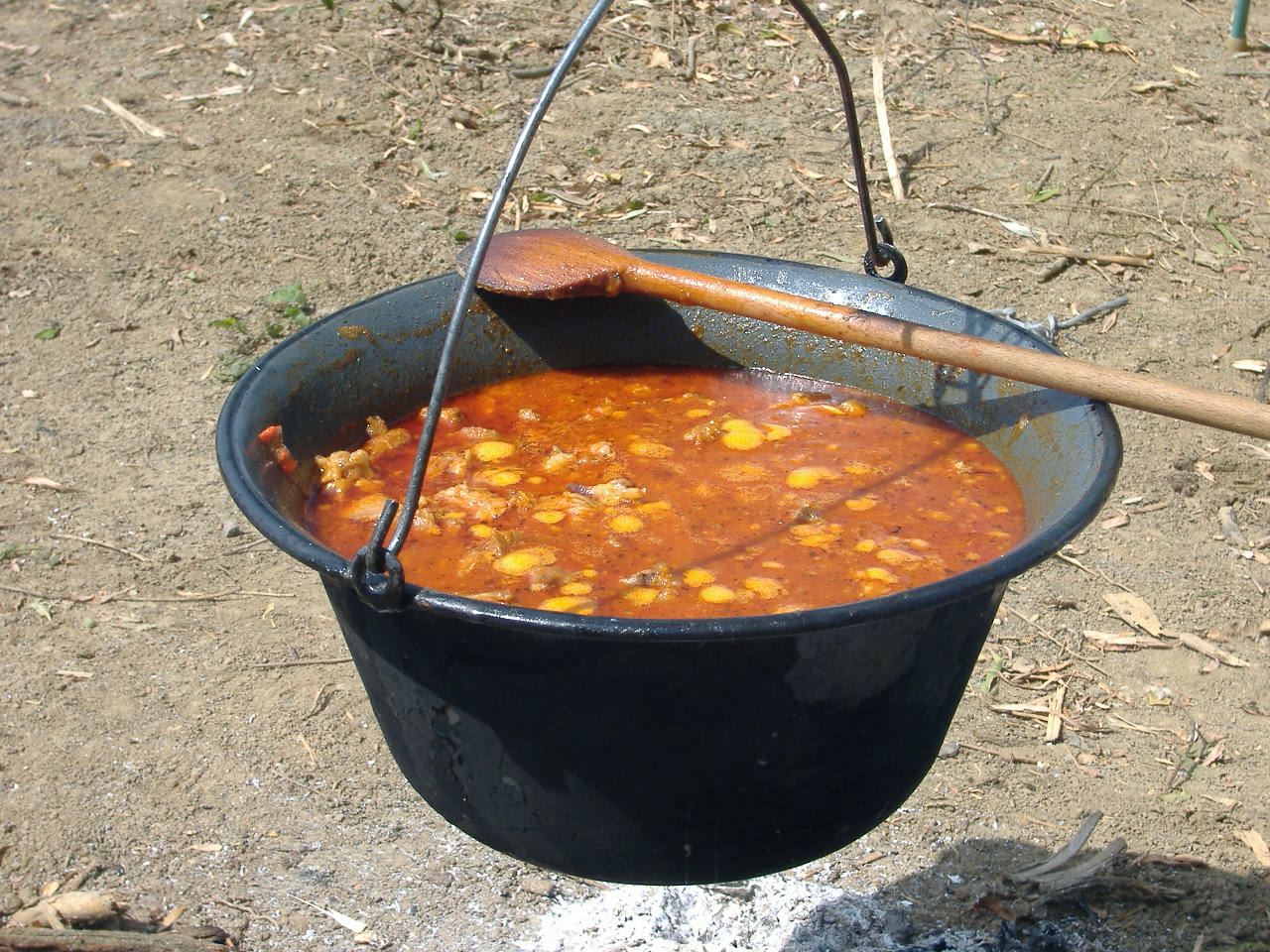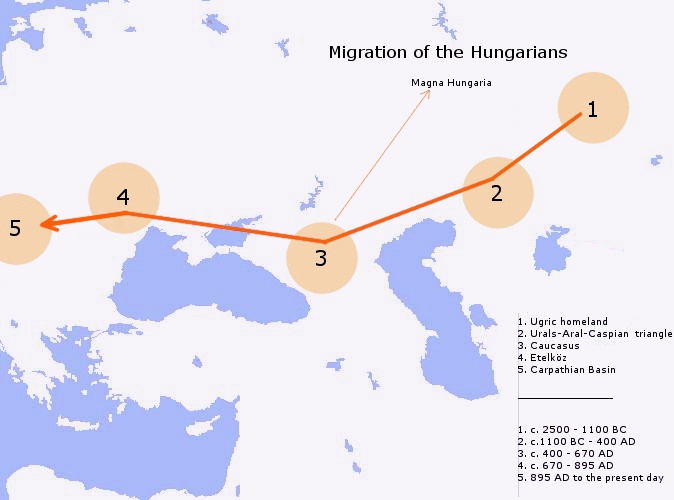|
Bogrács
The bogrács () is an outside fire cooking pot made of metal. It is suspended from a chain over a campfire. Its distinctive shape and diagonal handle distinguish it from similar cookware. The bogrács was commonly used by the serfs. Its spread can be traced back to the nomadic equestrian cultures, with the cauldron. The ancestor to the bogrács was brought to the Carpathian Basin by the first Hungarians. There are many types of bogrács used, made with different sizes, materials and uses. The word 'bogrács' comes from the word 'bakraç' - an Ottoman-Turkish word meaning 'copper bucket'. It is also considered a dish of Carpathian The Carpathian Mountains or Carpathians () are a range of mountains forming an arc across Central Europe and Southeast Europe. Roughly long, it is the third-longest European mountain range after the Urals at and the Scandinavian Mountains at ... cuisine. References {{DEFAULTSORT:Bogracs Cooking vessels Fireplaces ... [...More Info...] [...Related Items...] OR: [Wikipedia] [Google] [Baidu] |
Serfs
Serfdom was the status of many peasants under feudalism, specifically relating to manorialism and similar systems. It was a condition of debt bondage and indentured servitude with similarities to and differences from slavery. It developed during late antiquity and the Early Middle Ages in Europe and lasted in some countries until the mid-19th century. Unlike slaves, serfs could not be bought, sold, or traded individually, though they could, depending on the area, be sold together with land. Actual slaves, such as the kholops in Russia, could, by contrast, be traded like regular slaves, abused with no rights over their own bodies, could not leave the land they were bound to, and marry only with their lord's permission. Serfs who occupied a plot of land were required to work for the lord of the manor who owned that land. In return, they were entitled to protection, justice, and the right to cultivate certain fields within the manor to maintain their own subsistence. Serfs were ... [...More Info...] [...Related Items...] OR: [Wikipedia] [Google] [Baidu] |
Cauldron
A cauldron (or caldron) is a large cookware and bakeware, pot (kettle) for cooking or boiling over an open fire, with a lid and frequently with an arc-shaped hanger and/or integral handles or feet. There is a rich history of cauldron lore in religion, mythology, and folklore. Etymology The word cauldron is first recorded in Middle English as ''caudroun'' (13th century). It was borrowed from Norman language, Norman ''caudron''T. F. Hoad, ''English Etymology'', Oxford University Press, 1993 (). p. 67. (Picard language, Picard ''caudron'', ). It represents the phonetical evolution of Vulgar Latin ''*caldario'' for Classical Latin ''caldārium'' "hot bath", that derives from ''cal(i)dus'' "hot". The Norman-French word replaces the Old English ''ċetel'' (German ''(Koch)Kessel'' "cauldron", Dutch ''(kook)ketel'' "cauldron"), Middle English ''chetel''. The word "kettle" is a borrowing of the Old Norse variant ''ketill'' "cauldron". History From Latin origin, the term cauldron i ... [...More Info...] [...Related Items...] OR: [Wikipedia] [Google] [Baidu] |
Carpathian Basin
The Pannonian Basin, with the term Carpathian Basin being sometimes preferred in Hungarian literature, is a large sedimentary basin situated in southeastern Central Europe. After the Treaty of Trianon following World War I, the geomorphological term Pannonian Plain was also used for roughly the same region, referring to the lowlands in the area occupied by the Pannonian Sea during the Pliocene Epoch, however some consider the term "Pannonian Plain" not only unhistorical but also topologically erroneous. Terminology The term Pannonian Plain refers to the lowland parts of the Pannonian Basin as well as those of some adjoining regions like Lower Austria, Moravia, and Silesia (Czech Republic and Poland). The lands adjoining the plain proper are sometimes also called ''peri-Pannonian''. In English language, the terms "Pannonian Basin" and "Carpathian Basin" may sometimes be used synonymously, although the latter holds an irredentist Hungarian connotation. The name "Pannonian" ... [...More Info...] [...Related Items...] OR: [Wikipedia] [Google] [Baidu] |
Hungarians
Hungarians, also known as Magyars, are an Ethnicity, ethnic group native to Hungary (), who share a common Culture of Hungary, culture, Hungarian language, language and History of Hungary, history. They also have a notable presence in former parts of the Kingdom of Hungary. The Hungarian language belongs to the Ugric languages, Ugric branch of the Uralic languages, Uralic language family, alongside the Khanty languages, Khanty and Mansi languages, Mansi languages. There are an estimated 14.5 million ethnic Hungarians and their descendants worldwide, of whom 9.6 million live in today's Hungary. About 2 million Hungarians live in areas that were part of the Kingdom of Hungary before the Treaty of Trianon in 1920 and are now parts of Hungary's seven neighbouring countries, Hungarians in Slovakia, Slovakia, Hungarians in Ukraine, Ukraine, Hungarians in Romania, Romania, Hungarians in Serbia, Serbia, Hungarians of Croatia, Croatia, Prekmurje, Slovenia, and Hungarians in Austria, Aust ... [...More Info...] [...Related Items...] OR: [Wikipedia] [Google] [Baidu] |
Transcarpathia
Transcarpathia (, ) is a historical region on the border between Central and Eastern Europe, mostly located in western Ukraine's Zakarpattia Oblast. From the Hungarian Hungarian conquest of the Carpathian Basin, conquest of the Carpathian Basin (at the end of the 9th century) to the end of World War I (Treaty of Trianon in 1920), most of this region was part of the Kingdom of Hungary. In the interwar period, it was part of the First Czechoslovak Republic, First and Second Czechoslovak Republics. Before World War II, the region was annexed by the Kingdom of Hungary (1920–46), Kingdom of Hungary once again when Germany dismembered the Second Czechoslovak Republic. After the war, it was annexed by the Soviet Union and became part of the Ukrainian Soviet Socialist Republic. It is an ethnically diverse region, inhabited mostly by people who regard themselves as ethnic Ukrainians, Rusyns, Hungarian people, Hungarians, Romanians, Slovak people, Slovaks, and Polish people, Poles. It a ... [...More Info...] [...Related Items...] OR: [Wikipedia] [Google] [Baidu] |
Cooking Vessels
Cooking, also known as cookery or professionally as the culinary arts, is the art, science and craft of using heat to make food more palatable, digestible, nutritious, or safe. Cooking techniques and ingredients vary widely, from grilling food over an open fire to using electric stoves, to baking in various types of ovens, reflecting local conditions. Types of cooking also depend on the skill levels and training of the cooks. Cooking is done both by people in their own dwellings and by professional cooks and chefs in restaurants and other food establishments. Preparing food with heat or fire is an activity unique to humans. Archeological evidence of cooking fires from at least 300,000 years ago exists, but some estimate that humans started cooking up to 2 million years ago. The expansion of agriculture, commerce, trade, and transportation between civilizations in different regions offered cooks many new ingredients. New inventions and technologies, such as the invention of ... [...More Info...] [...Related Items...] OR: [Wikipedia] [Google] [Baidu] |




